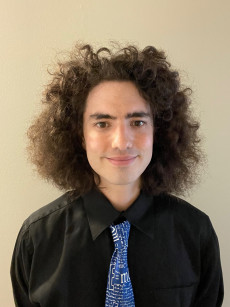SCGSR Fellow Brings Astrophysics Data Skills to Berkeley Lab and Black Holes
November 28, 2022
By Kathy Kincade
Contact: cscomms@lbl.gov
Peter Craig, a graduate student at the Rochester Institute of Technology (RIT), has spent much of 2022 working with researchers in the Berkeley Lab Applied Mathematics and Computational Research (AMCR) division scouring through a new, massive astrophysics dataset looking for previously unidentified binary black holes.
In a paper submitted to Astrophysical Journal Oct. 19, a team of 11 researchers from multiple U.S. institutions – including Craig and his graduate advisor Sukanya Chakrabarti, a physics professor at The University of Alabama in Huntsville and lead author on the paper – describe how they used this dataset and supporting instrumentation to discover a monster black hole that has about 12 times the mass of the sun.
To find this object, the collaborators analyzed data of nearly 200,000 binary stars released over the summer from the European Space Agency’s Gaia satellite mission. Interesting sources were followed up with spectrographic measurements from various telescopes, including the Automated Planet Finder in California, Chile’s Magellan Telescopes, and the W.M. Keck Observatory in Hawaii.
“Simple estimates suggest that there are about a million visible stars that have massive black hole companions in our galaxy,” said Dr. Chakrabarti. “But there are a hundred billion stars in our galaxy, so it is like looking for a needle in a haystack. The Gaia mission, with its incredibly precise measurements, made it easier by narrowing down our search.”
The data analytics aspects of this project took Craig into some uncharted territory, a challenge he welcomed.
“This is something different than anything I’ve worked on before,” said Craig, who is third author on the new paper. “We are starting to get a chance to look at these non-interacting black-hole binaries, which is this large population of black holes in the Milky Way – at least we think it should be a large population – and it’s something we’ve never really been able to study before because they are pretty hard to find. But we are getting to a point where we can actually start to detect them and begin to understand what they can tell us about how black holes form.”
Craig, who is pursuing a PhD in astrophysical sciences and technology, came to Berkeley Lab through a year-long fellowship from the U.S. Department of Energy’s Office of Science Graduate Student Research (SCGSR) program and is working with Peter Nugent, a senior scientist in AMCR and Division Deputy for Science Engagement. Craig applied for the SCGSR fellowship at the urging of Chakrabarti.
“This opportunity is going to do a couple of things that will help me continue in astronomy,” he said. “First, it lets me work on some cool things that are a bit different from what I’d already been working on. Also, we are going to produce interesting results that we think are going to make a difference in the next few years as far as getting some good scientific results out, which is always a good thing. But probably the biggest thing has been the chance to spend some time somewhere else and meet new people. I’ve been going around and giving talks at places here in the Bay Area and meeting new people, and that’s an opportunity you don’t get when you stay at your home institution.”
The overarching goal of the SCGSR program is to prepare graduate students for STEM careers critically important to the DOE Office of Science mission by providing graduate thesis students research opportunities at DOE laboratories. The program provides supplemental awards to outstanding U.S. graduate students to pursue part of their graduate thesis research at a DOE laboratory/facility in areas that address scientific challenges central to the Office of Science mission.
Looking ahead, Craig is already thinking about what his focus will be once the fellowship ends. In addition to finishing his Ph.D. thesis, “there are a few other sources we think might potentially point to black holes. So once I’m back at RIT, I’ll start looking at some of them to see if we can find other black holes, and that might turn into a project that I’ll be leading some time in December/January. It would be pretty exciting if we could find more.”
This story includes information from a University of Alabama, Huntsville news release.
About Berkeley Lab
Founded in 1931 on the belief that the biggest scientific challenges are best addressed by teams, Lawrence Berkeley National Laboratory and its scientists have been recognized with 16 Nobel Prizes. Today, Berkeley Lab researchers develop sustainable energy and environmental solutions, create useful new materials, advance the frontiers of computing, and probe the mysteries of life, matter, and the universe. Scientists from around the world rely on the Lab’s facilities for their own discovery science. Berkeley Lab is a multiprogram national laboratory, managed by the University of California for the U.S. Department of Energy’s Office of Science.
DOE’s Office of Science is the single largest supporter of basic research in the physical sciences in the United States, and is working to address some of the most pressing challenges of our time. For more information, please visit energy.gov/science.










